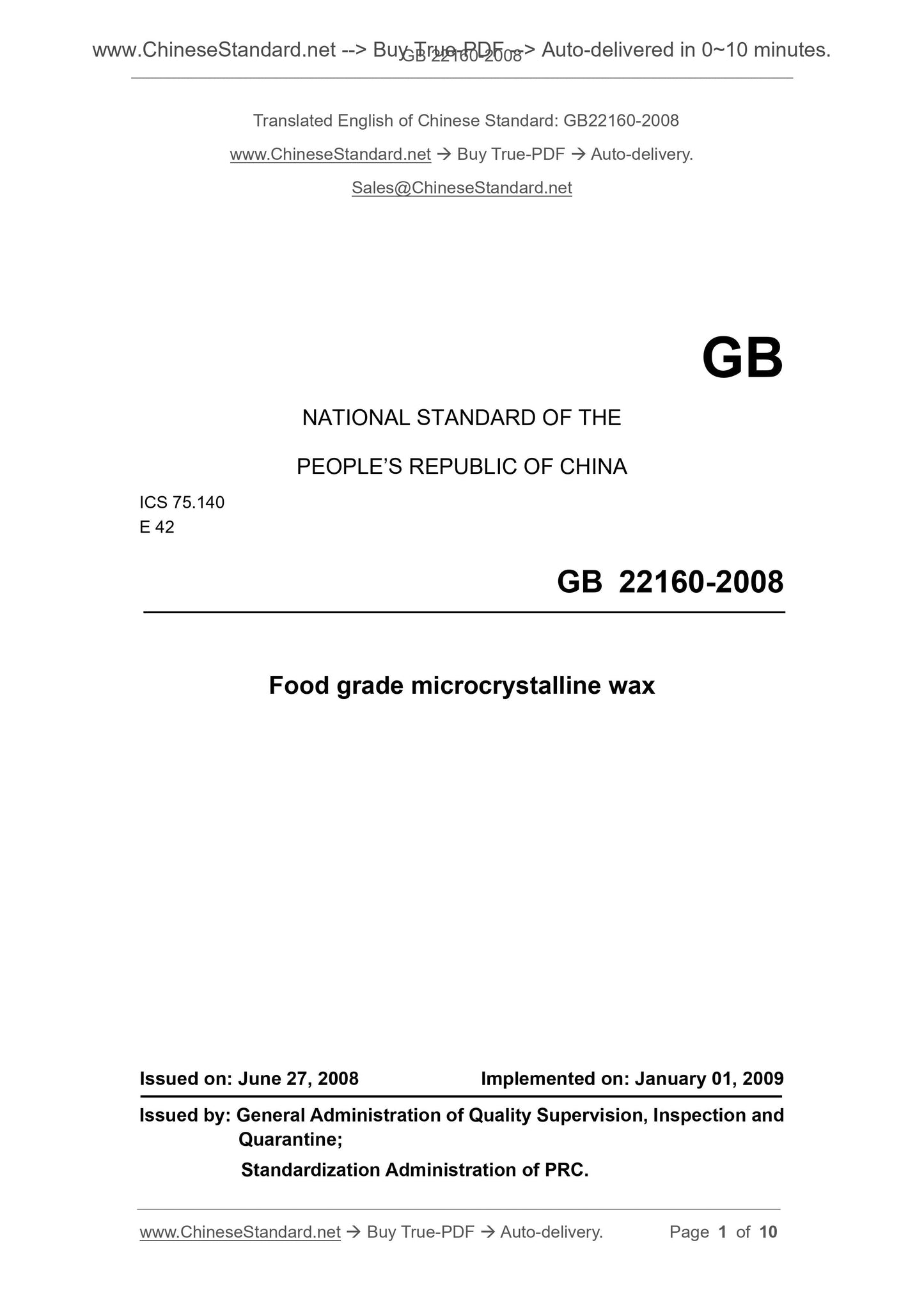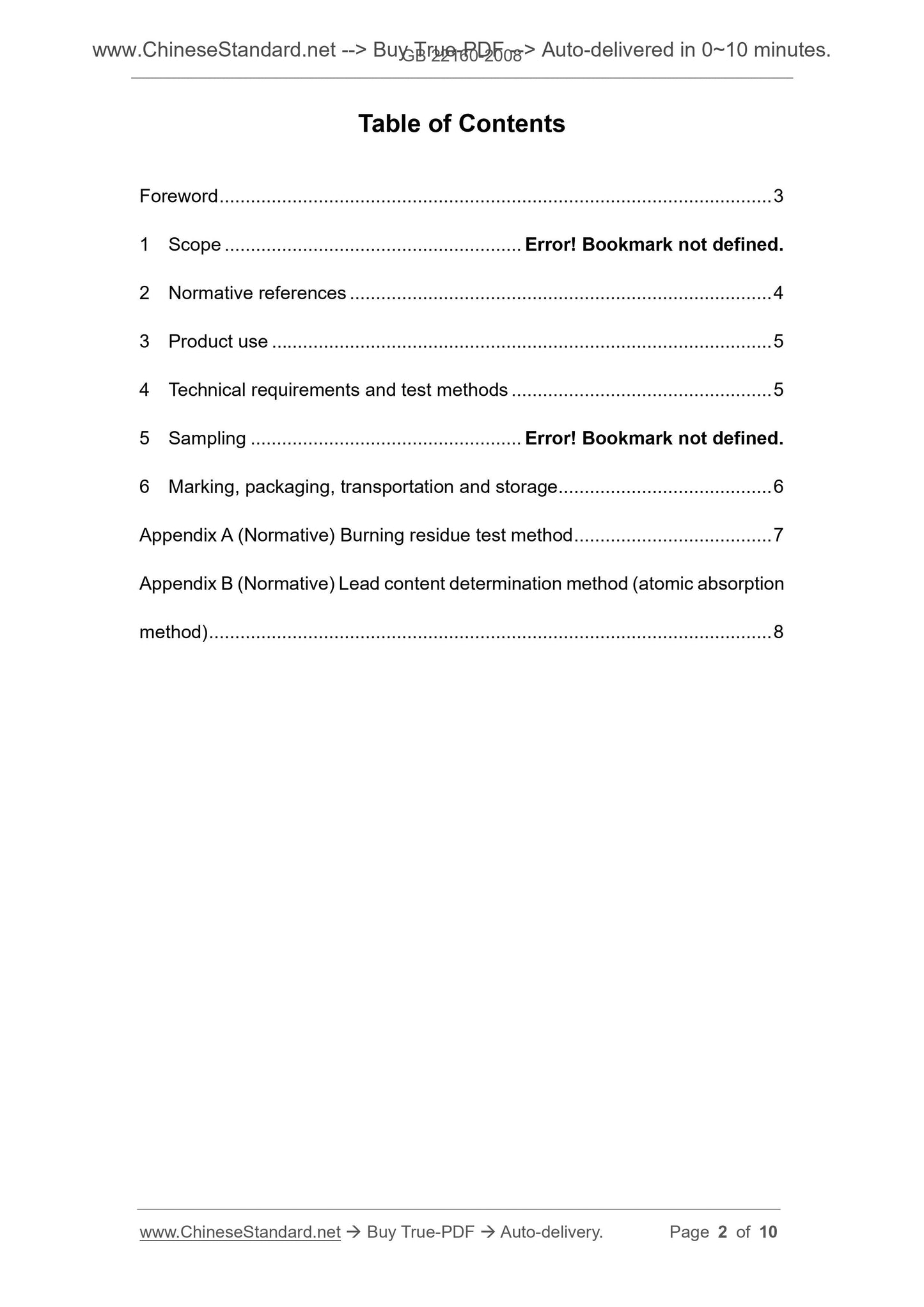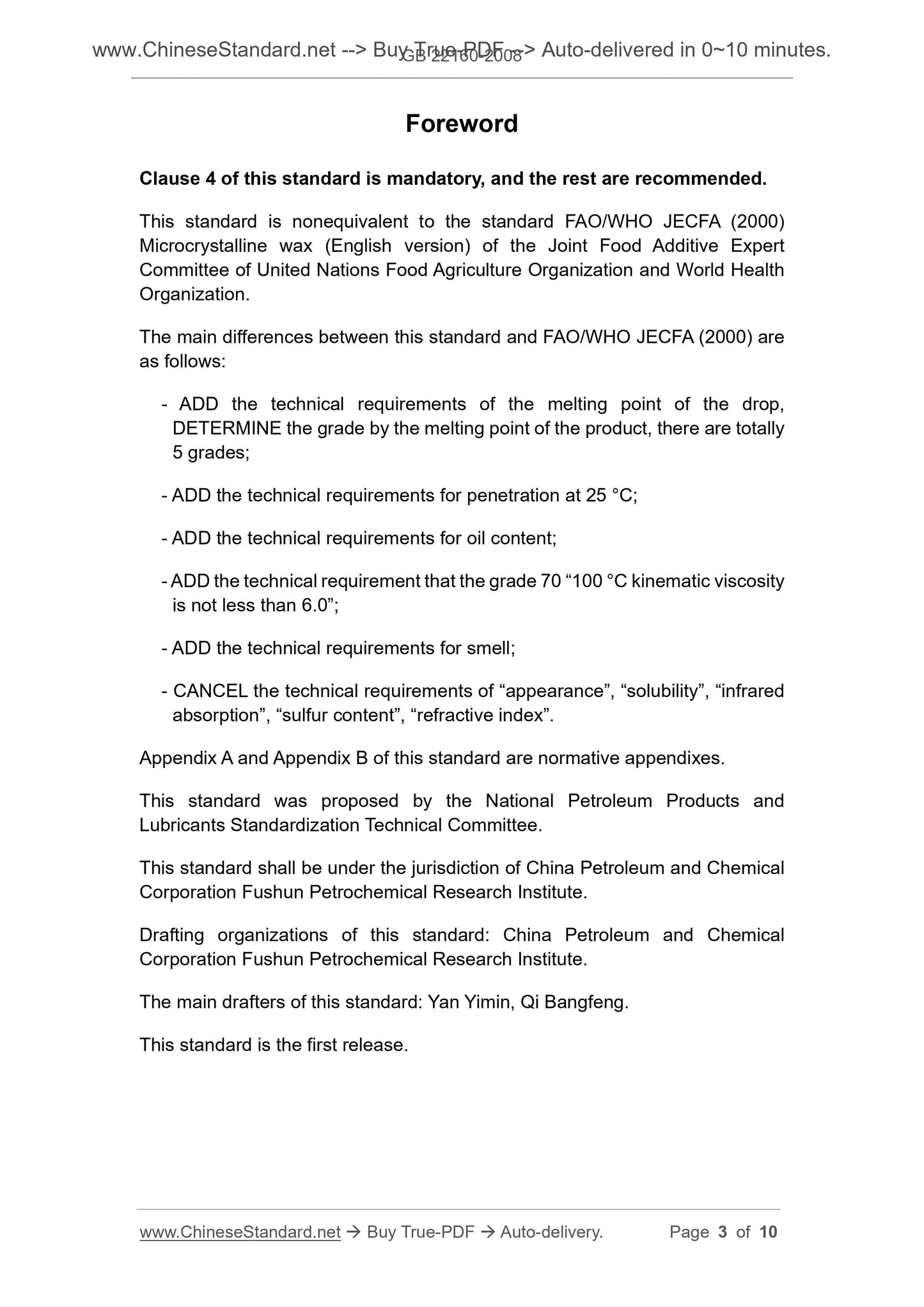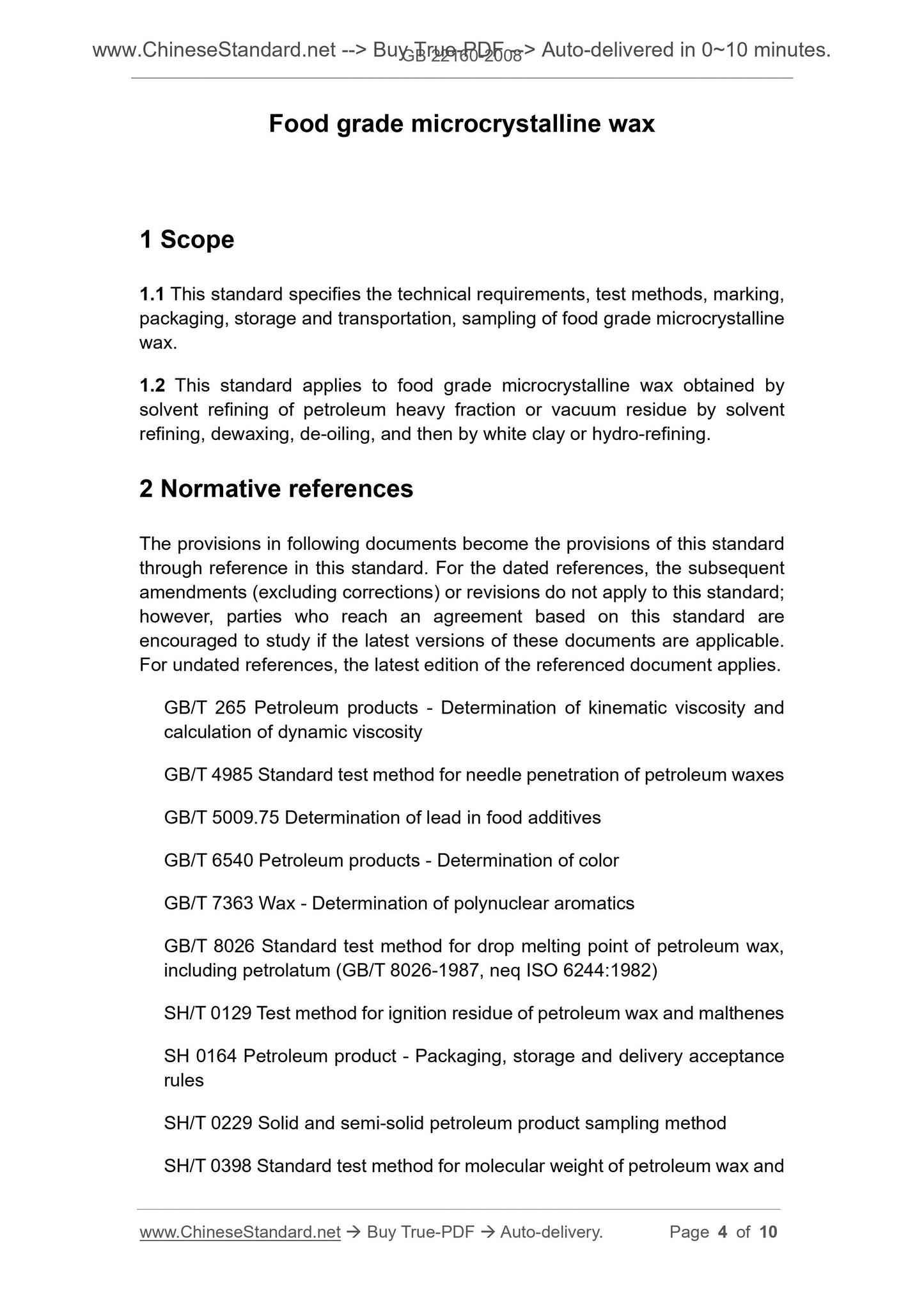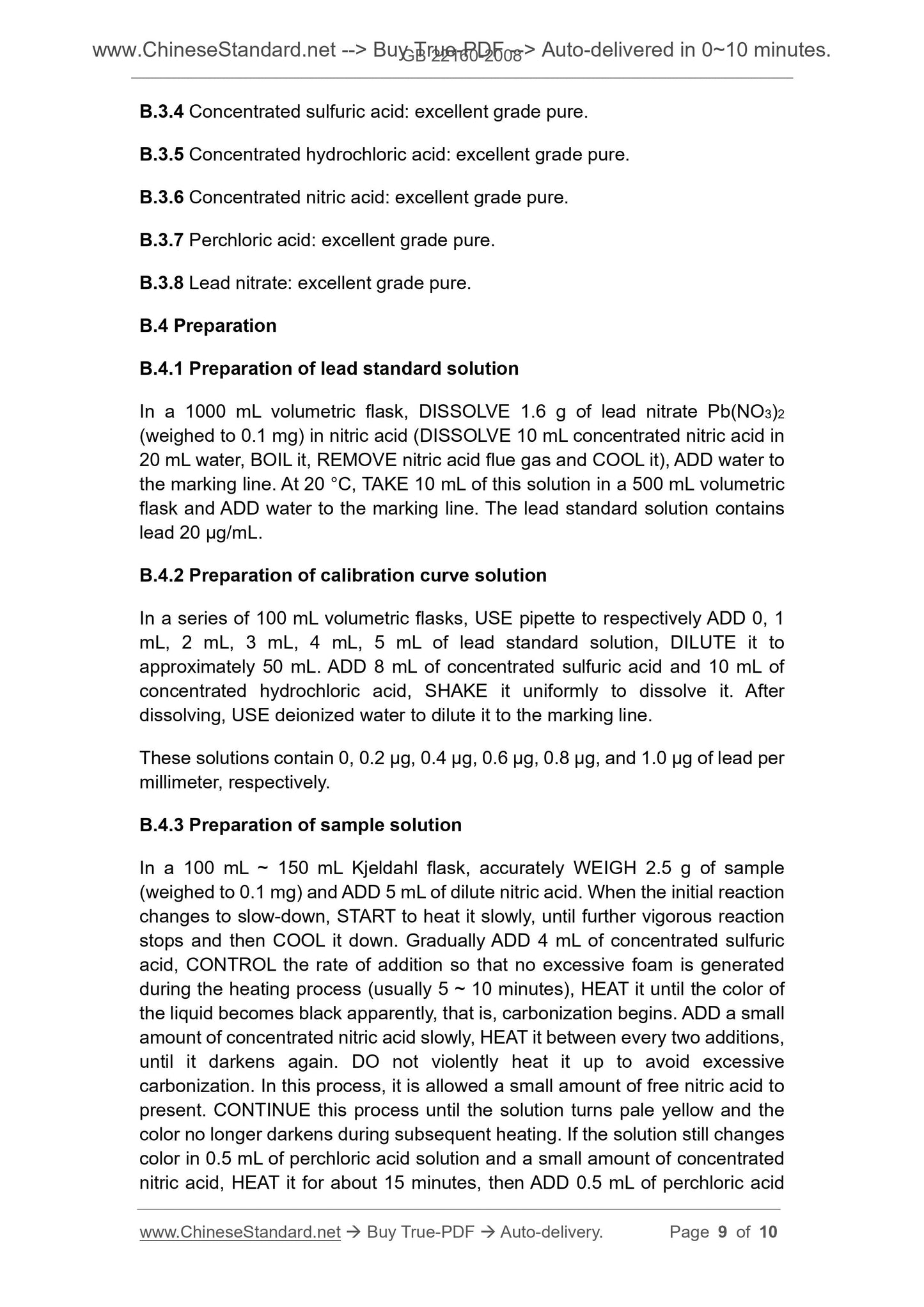1
/
of
5
PayPal, credit cards. Download editable-PDF & invoice in 1 second!
GB 22160-2008 English PDF
GB 22160-2008 English PDF
Regular price
$145.00 USD
Regular price
Sale price
$145.00 USD
Unit price
/
per
Shipping calculated at checkout.
Couldn't load pickup availability
Delivery: 3 seconds. Download true-PDF + Invoice.
Get QUOTATION in 1-minute: Click GB 22160-2008
Historical versions: GB 22160-2008
Preview True-PDF (Reload/Scroll if blank)
GB 22160-2008: Food grade microcrystalline wax
GB 22160-2008
GB
NATIONAL STANDARD OF THE
PEOPLE’S REPUBLIC OF CHINA
ICS 75.140
E 42
Food grade microcrystalline wax
ISSUED ON. JUNE 27, 2008
IMPLEMENTED ON. JANUARY 01, 2009
Issued by. General Administration of Quality Supervision, Inspection and
Quarantine;
Standardization Administration of PRC.
Table of Contents
Foreword ... 3
1 Scope ... Error! Bookmark not defined.
2 Normative references ... 4
3 Product use ... 5
4 Technical requirements and test methods ... 5
5 Sampling ... Error! Bookmark not defined.
6 Marking, packaging, transportation and storage ... 6
Appendix A (Normative) Burning residue test method ... 7
Appendix B (Normative) Lead content determination method (atomic absorption
method) ... 8
Foreword
Clause 4 of this standard is mandatory, and the rest are recommended.
This standard is nonequivalent to the standard FAO/WHO JECFA (2000)
Microcrystalline wax (English version) of the Joint Food Additive Expert
Committee of United Nations Food Agriculture Organization and World Health
Organization.
The main differences between this standard and FAO/WHO JECFA (2000) are
as follows.
- ADD the technical requirements of the melting point of the drop,
DETERMINE the grade by the melting point of the product, there are totally
5 grades;
- ADD the technical requirements for penetration at 25 °C;
- ADD the technical requirements for oil content;
- ADD the technical requirement that the grade 70 “100 °C kinematic viscosity
is not less than 6.0”;
- ADD the technical requirements for smell;
- CANCEL the technical requirements of “appearance”, “solubility”, “infrared
absorption”, “sulfur content”, “refractive index”.
Appendix A and Appendix B of this standard are normative appendixes.
This standard was proposed by the National Petroleum Products and
Lubricants Standardization Technical Committee.
This standard shall be under the jurisdiction of China Petroleum and Chemical
Corporation Fushun Petrochemical Research Institute.
Drafting organizations of this standard. China Petroleum and Chemical
Corporation Fushun Petrochemical Research Institute.
The main drafters of this standard. Yan Yimin, Qi Bangfeng.
This standard is the first release.
Food grade microcrystalline wax
1 Scope
1.1 This standard specifies the technical requirements, test methods, marking,
packaging, storage and transportation, sampling of food grade microcrystalline
wax.
1.2 This standard applies to food grade microcrystalline wax obtained by
solvent refining of petroleum heavy fraction or vacuum residue by solvent
refining, dewaxing, de-oiling, and then by white clay or hydro-refining.
2 Normative references
The provisions in following documents become the provisions of this standard
through reference in this standard. For the dated references, the subsequent
amendments (excluding corrections) or revisions do not apply to this standard;
however, parties who reach an agreement based on this standard are
encouraged to study if the latest versions of these documents are applicable.
For undated references, the latest edition of the referenced document applies.
GB/T 265 Petroleum products - Determination of kinematic viscosity and
calculation of dynamic viscosity
GB/T 4985 Standard test method for needle penetration of petroleum waxes
GB/T 5009.75 Determination of lead in food additives
GB/T 6540 Petroleum products - Determination of color
GB/T 7363 Wax - Determination of polynuclear aromatics
GB/T 8026 Standard test method for drop melting point of petroleum wax,
including petrolatum (GB/T 8026-1987, neq ISO 6244.1982)
SH/T 0129 Test method for ignition residue of petroleum wax and malthenes
SH 0164 Petroleum product - Packaging, storage and delivery acceptance
rules
SH/T 0229 Solid and semi-solid petroleum product sampling method
SH/T 0398 Standard test method for molecular weight of petroleum wax and
B.3.4 Concentrated sulfuric acid. excellent grade pure.
B.3.5 Concentrated hydrochloric acid. excellent grade pure.
B.3.6 Concentrated nitric acid. excellent grade pure.
B.3.7 Perchloric acid. excellent grade pure.
B.3.8 Lead nitrate. excellent grade pure.
B.4 Preparation
B.4.1 Preparation of lead standard solution
In a 1000 mL volumetric flask, DISSOLVE 1.6 g of lead nitrate Pb(NO3)2
(weighed to 0.1 mg) in nitric acid (DISSOLVE 10 mL concentrated nitric acid in
20 mL water, BOIL it, REMOVE nitric acid flue gas and COOL it), ADD water to
the marking line. At 20 °C, TAKE 10 mL of this solution in a 500 mL volumetric
flask and ADD water to the marking line. The lead standard solution contains
lead 20 μg/mL.
B.4.2 Preparation of calibration curve solution
In a series of 100 mL volumetric flasks, USE pipette to respectively ADD 0, 1
mL, 2 mL, 3 mL, 4 mL, 5 mL of lead standard solution, DILUTE it to
approximately 50 mL. ADD 8 mL of concentrated sulfuric acid and 10 mL of
concentrated hydrochloric acid, SHAKE it uniformly to dissolve it. After
dissolving, USE deionized water to dilute it to the marking line.
These solutions contain 0, 0.2 μg, 0.4 μg, 0.6 μg, 0.8 μg, and 1.0 μg of lead per
millimeter, respectively.
B.4.3 Preparation of sample solution
In a 100 mL ~ 150 mL Kjeldahl flask, accurately WEIGH 2.5 g of sample
(weighed to 0.1 mg) and ADD 5 mL of dilute nitric acid. When the initial reaction
changes to slow-down, START to heat it slowly, until further vigorous reaction
stops and then COOL it down. Gradually ADD 4 mL of concentrated sulfuric
acid, CONTROL the rate of addition so that no excessive foam is generated
during the heating process (usually 5 ~ 10 minutes), HEAT it until the color of
the liquid becomes black apparently, that is, carbonization begins. ADD a small
amount of concentrated nitric acid slowly, HEAT it between every two additions,
until it darkens again. DO not violently heat it up to avoid excessive
carbonization. In this process, it is allowed a small amount of free nitric acid to
present. CONTINUE this process until the solution turns pale yellow and the
color no longer darkens during subsequent heating. If the solution still changes
color in 0.5 mL of perchloric acid solution and a small amount of concentrated
nitric acid, HEAT it for about 15 minutes, then ADD 0.5 mL of perchloric acid
Get QUOTATION in 1-minute: Click GB 22160-2008
Historical versions: GB 22160-2008
Preview True-PDF (Reload/Scroll if blank)
GB 22160-2008: Food grade microcrystalline wax
GB 22160-2008
GB
NATIONAL STANDARD OF THE
PEOPLE’S REPUBLIC OF CHINA
ICS 75.140
E 42
Food grade microcrystalline wax
ISSUED ON. JUNE 27, 2008
IMPLEMENTED ON. JANUARY 01, 2009
Issued by. General Administration of Quality Supervision, Inspection and
Quarantine;
Standardization Administration of PRC.
Table of Contents
Foreword ... 3
1 Scope ... Error! Bookmark not defined.
2 Normative references ... 4
3 Product use ... 5
4 Technical requirements and test methods ... 5
5 Sampling ... Error! Bookmark not defined.
6 Marking, packaging, transportation and storage ... 6
Appendix A (Normative) Burning residue test method ... 7
Appendix B (Normative) Lead content determination method (atomic absorption
method) ... 8
Foreword
Clause 4 of this standard is mandatory, and the rest are recommended.
This standard is nonequivalent to the standard FAO/WHO JECFA (2000)
Microcrystalline wax (English version) of the Joint Food Additive Expert
Committee of United Nations Food Agriculture Organization and World Health
Organization.
The main differences between this standard and FAO/WHO JECFA (2000) are
as follows.
- ADD the technical requirements of the melting point of the drop,
DETERMINE the grade by the melting point of the product, there are totally
5 grades;
- ADD the technical requirements for penetration at 25 °C;
- ADD the technical requirements for oil content;
- ADD the technical requirement that the grade 70 “100 °C kinematic viscosity
is not less than 6.0”;
- ADD the technical requirements for smell;
- CANCEL the technical requirements of “appearance”, “solubility”, “infrared
absorption”, “sulfur content”, “refractive index”.
Appendix A and Appendix B of this standard are normative appendixes.
This standard was proposed by the National Petroleum Products and
Lubricants Standardization Technical Committee.
This standard shall be under the jurisdiction of China Petroleum and Chemical
Corporation Fushun Petrochemical Research Institute.
Drafting organizations of this standard. China Petroleum and Chemical
Corporation Fushun Petrochemical Research Institute.
The main drafters of this standard. Yan Yimin, Qi Bangfeng.
This standard is the first release.
Food grade microcrystalline wax
1 Scope
1.1 This standard specifies the technical requirements, test methods, marking,
packaging, storage and transportation, sampling of food grade microcrystalline
wax.
1.2 This standard applies to food grade microcrystalline wax obtained by
solvent refining of petroleum heavy fraction or vacuum residue by solvent
refining, dewaxing, de-oiling, and then by white clay or hydro-refining.
2 Normative references
The provisions in following documents become the provisions of this standard
through reference in this standard. For the dated references, the subsequent
amendments (excluding corrections) or revisions do not apply to this standard;
however, parties who reach an agreement based on this standard are
encouraged to study if the latest versions of these documents are applicable.
For undated references, the latest edition of the referenced document applies.
GB/T 265 Petroleum products - Determination of kinematic viscosity and
calculation of dynamic viscosity
GB/T 4985 Standard test method for needle penetration of petroleum waxes
GB/T 5009.75 Determination of lead in food additives
GB/T 6540 Petroleum products - Determination of color
GB/T 7363 Wax - Determination of polynuclear aromatics
GB/T 8026 Standard test method for drop melting point of petroleum wax,
including petrolatum (GB/T 8026-1987, neq ISO 6244.1982)
SH/T 0129 Test method for ignition residue of petroleum wax and malthenes
SH 0164 Petroleum product - Packaging, storage and delivery acceptance
rules
SH/T 0229 Solid and semi-solid petroleum product sampling method
SH/T 0398 Standard test method for molecular weight of petroleum wax and
B.3.4 Concentrated sulfuric acid. excellent grade pure.
B.3.5 Concentrated hydrochloric acid. excellent grade pure.
B.3.6 Concentrated nitric acid. excellent grade pure.
B.3.7 Perchloric acid. excellent grade pure.
B.3.8 Lead nitrate. excellent grade pure.
B.4 Preparation
B.4.1 Preparation of lead standard solution
In a 1000 mL volumetric flask, DISSOLVE 1.6 g of lead nitrate Pb(NO3)2
(weighed to 0.1 mg) in nitric acid (DISSOLVE 10 mL concentrated nitric acid in
20 mL water, BOIL it, REMOVE nitric acid flue gas and COOL it), ADD water to
the marking line. At 20 °C, TAKE 10 mL of this solution in a 500 mL volumetric
flask and ADD water to the marking line. The lead standard solution contains
lead 20 μg/mL.
B.4.2 Preparation of calibration curve solution
In a series of 100 mL volumetric flasks, USE pipette to respectively ADD 0, 1
mL, 2 mL, 3 mL, 4 mL, 5 mL of lead standard solution, DILUTE it to
approximately 50 mL. ADD 8 mL of concentrated sulfuric acid and 10 mL of
concentrated hydrochloric acid, SHAKE it uniformly to dissolve it. After
dissolving, USE deionized water to dilute it to the marking line.
These solutions contain 0, 0.2 μg, 0.4 μg, 0.6 μg, 0.8 μg, and 1.0 μg of lead per
millimeter, respectively.
B.4.3 Preparation of sample solution
In a 100 mL ~ 150 mL Kjeldahl flask, accurately WEIGH 2.5 g of sample
(weighed to 0.1 mg) and ADD 5 mL of dilute nitric acid. When the initial reaction
changes to slow-down, START to heat it slowly, until further vigorous reaction
stops and then COOL it down. Gradually ADD 4 mL of concentrated sulfuric
acid, CONTROL the rate of addition so that no excessive foam is generated
during the heating process (usually 5 ~ 10 minutes), HEAT it until the color of
the liquid becomes black apparently, that is, carbonization begins. ADD a small
amount of concentrated nitric acid slowly, HEAT it between every two additions,
until it darkens again. DO not violently heat it up to avoid excessive
carbonization. In this process, it is allowed a small amount of free nitric acid to
present. CONTINUE this process until the solution turns pale yellow and the
color no longer darkens during subsequent heating. If the solution still changes
color in 0.5 mL of perchloric acid solution and a small amount of concentrated
nitric acid, HEAT it for about 15 minutes, then ADD 0.5 mL of perchloric acid
Share
